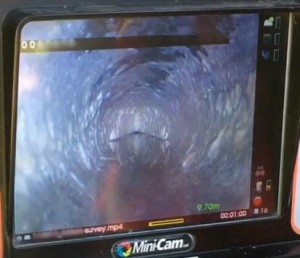Many Laingholm residents are now aware that Laingholm Beach is unsafe to swim due to poor water quality resulting from fecal contamination. The Council web site www.SafeSwim.org.nz lists Laingholm Beach under the category “Long term water quality alerts – we recommend you don’t swim at these spots”. Action definitely needs to be taken by Watercare and Auckland Council, but the purpose of this article is to look at our individual contribution to the problem and look at how our everyday actions at home may be contributing to the contamination of Laingholm Beach.
The wastewater infrastructure in Laingholm is relatively recent compared to many parts of Auckland. Most of the wastewater pipes are not cracked and have not been penetrated by tree roots. However, a neighbour and I have both been having regular wastewater overflows emerging from the manholes at the back of our yards. A quick call to Watercare and they arrive within hours, unblock the pipe and clean it up, but the same problem happens again in about a year’s time. I kept calling Watercare and asking for a proper investigation and repair and eventually a CCTV crew was sent out. They’ve put a camera down the pipe and did not find a single crack or tree root. However, they saw that there was a slight dip in the pipe – a stretch of the pipe went down by about 10cm and then up again. And this dip was being clogged with solidified fat and women’s sanitary pads.
 When cooking fat, oil or grease, lard or hot butter is poured down the sink or into the toilet the residents are generally unaware that they are causing a problem – warm fat flows through the drain and disappears just fine. However, when fat reaches a dip in the wastewater pipe it cools down, solidifies and sticks to the inner walls of the pipe. Month after month the thickness of this layer of solidified fat increases and a “fatberg” forms. This is similar to how cholesterol blocks a blood artery inside a human body. When someone then flushes some wet wipes or a sanitary pad, or if the fatberg simply grows large enough, the wastewater and poo can no longer pass, the pipe blocks up, and everything that goes down the toilets and drains flows out from the nearest manhole. If the manhole is not next to someone’s house the overflow may remain unnoticed for a long time. The rains will wash this human waste into the nearest creek or stormwater drain and it ends up in a Laingholm bay.
When cooking fat, oil or grease, lard or hot butter is poured down the sink or into the toilet the residents are generally unaware that they are causing a problem – warm fat flows through the drain and disappears just fine. However, when fat reaches a dip in the wastewater pipe it cools down, solidifies and sticks to the inner walls of the pipe. Month after month the thickness of this layer of solidified fat increases and a “fatberg” forms. This is similar to how cholesterol blocks a blood artery inside a human body. When someone then flushes some wet wipes or a sanitary pad, or if the fatberg simply grows large enough, the wastewater and poo can no longer pass, the pipe blocks up, and everything that goes down the toilets and drains flows out from the nearest manhole. If the manhole is not next to someone’s house the overflow may remain unnoticed for a long time. The rains will wash this human waste into the nearest creek or stormwater drain and it ends up in a Laingholm bay.
So what can we do?
- Ask all members of your household (especially the cooks) to never pour cooking fat, oil or grease, lard or hot butter down the drain or toilet. Pour it into your compost bin, hole in the ground, or just into the bush on your property, it will biodegrade. Or into paper towels and into the rubbish bin.
- Ask all members of your household to never flush wet wipes, tampons or sanitary pads.
- Find out if there are any wastewater manholes on your property and inspect them visually every month or two. This information is easy to find: go to www.AucklandCouncil.govt.nz and click GeoMaps, then find your address in the top bar. Next, click the second icon in the top row and choose “Assets”, then under “Legend” on the left expand “Underground Services” and tick “Wastewater”. Finally, click the first icon in the top row and choose “Aerial Basemap”. You will see an aerial photo of your property and its boundaries. The red circles are wastewater manholes.
- Info & Posters: www.WaterCare.co.nz – click “Faults and outages” then “Plumbing and wastewater”.
PUBLISHED IN APR 2018 ISSUE OF LAINGHOLM ROUNDABOUT.
